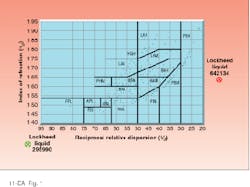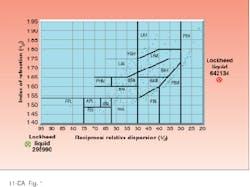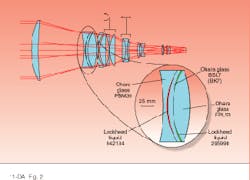Design and Applications
Design and Applications
Liquid optics create high-performance zoom lens
Iain A. Neil
After signing a licensing agreement with Lockheed International (Palo Alto, CA) for its liquid-lens technology, Panavision International (Tarzana, CA) explored the benefits of using liquid elements in a complex lens for its Primo lens series by designing a long-focal-length lens with continuous macro focusing. Correction of high-order monochromatic and chromatic aberrations is critical to system performance and is neither technically nor economically feasible with existing optical glasses.
Available commercial designs have depended on the use of anomalous-dispersion glasses and crystalline materials. These have many drawbacks: they are expensive, heavy, and unavailable in larger sizes. Optical liquids, on the other hand, are economical, lightweight, readily available, and generally have extremely abnormal dispersion characteristics (see Fig. 1). A hybrid glass/liquid approach constitutes a good solution for this type of long-focal-length lens.
System parameters
The proposed system was a 700-mm-focal-length, f/2.75 aperture lens with constant-aperture close-focusing to less than 7 ft from object to image and a 2:1 magnification. To minimize size, weight, and cost, initial plans called for the lens to be of telephoto construction with a single spherical front-objective element; optical liquids were to be used in place of anomalous-dispersion glasses. Macro focusing would be achieved with either one or two internally focusing lens groups located between the rear of the telephoto objective and the stop.
The first-order design comprised five lens groups, three stationary and two movable. The objective grouping would provide the telephoto configuration, the focus grouping would offer macro focusing capability, and the auxiliary grouping would perform final imaging. The stop, located in the auxiliary grouping, would supply the system with a constant aperture throughout the entire focus range. The possible final design of the telephoto objective would incorporate a single spherical front-objective element and a hybrid rear telephoto grouping containing a combination of liquid, glass, and crystal lens elements. The internal focusing power arrangement was designed to correct high-order aberrations while maintaining a minimum front-objective diameter dependent on entrance pupil control.
Once the first-order design was determined, fictitious nondispersive glasses with high indices of refraction (n = 11) at an intermediate wavelength (l = 546 nm) were inserted to determine which high-power elements needed to be split. In second-stage optimization, the existing fictitious glasses were replaced with another, more realistic set of glasses. Where excessive powers or bends arose, elements were again split.
Care was taken to ensure that first-order properties, including focal length, focus distance, overall length, back focal distance, front-aperture diameter, distortion, and close-focusing capabilities were maintained. In the third, and most difficult, stage, real glasses and liquids were inserted into the design and the final lens group configurations were determined. Lastly, Lockheed designers analyzed the Panavision design to verify performance results, particularly at high and low temperatures.
Strictly speaking, the Primo 700-mm lens has no zoom groups, per se. However, there are several parameters that need to be `zoomed` during the design process so that the lens data is multiconfigured. Initially, three configurations were required in which the focusing group air spaces were `zoomed` to provide three object-space focus distances: infinity, intermediate (nominal), and close-focus. With the introduction of the liquid elements, two more configurations set at the nominal focus were necessary for control of thermal defocus and thermal variations in aberration balance caused by the liquid elements. The refractive indices of the liquids and the anomalous-dispersion glass were `zoomed` to an elevated temperature of 40°C and a depressed temperature of 0°C. Another two focusing configurations, for a total of seven, were necessary to smooth out performance variations through focus and eliminate discontinuities in the focus group loci.
Aberration correction
In a large-aperture, long-focal-length lens, high-order monochromatic aberrations are in abundance. In the case of the Primo 700-mm lens, the task of correcting the monochromatic aberrations is made difficult by the design requirement of a single spherical primary objective element. During the preliminary design stages, it became apparent that the single front telephoto objective element was indeed feasible, but only in conjunction with a three-or-more-element rear telephoto objective grouping. Coincidentally, a minimum of three elements needed to be present in the rear telephoto group to properly support the liquid-lens elements.
Perhaps the greatest challenge in design of large-aperture, long-focal-length lenses is the correction of longitudinal chromatic aberration (LCA). In this case, the task was onerous due to the broad spectral range (435 to 656 nm) served by the lens. Eliminating LCA in the 435- to 486-nm wavelength region was particularly difficult. By including a single abnormal-dispersion optical liquid element in the rear telephoto objective grouping, with all other lens elements composed of normal-dispersion glasses, we were able to achieve a well-corrected system.
Unfortunately, the rapid change in refractive index of an optical liquid as a function of temperature (dn/dT) made the design almost unusable in motion-picture applications where a `take` may last four to five minutes. The solution to this thermal defocusing involved using a second optical liquid of nearly equal but opposite power to correct the defocus. The dn/dT for most optical liquids varies as a function of wavelength, however. The slopes of these curves for the two liquids were mismatched such that either the thermal defocus or the thermal aberration correction could be constant, but both could not be constant simultaneously. We introduced a single anomalous-dispersion glass element with appropriate dn/dT characteristics to achieve simultaneous correction of thermally induced aberration and focus changes.
Optimizing the lens system
The final-design rear telephoto quintuplet contains two liquids, two normal glasses, and one anomalous-dispersion glass in an optimized lens system with low residual chromatic aberration at all focus distances and temperatures (see Fig. 2, inset). As development of optical liquid technology continues, complementary optical liquid materials should become available, thus eliminating the need for anomalous-dispersion glasses.
The close-focus magnification of about 2:1 and constant-aperture through-focus of this lens means that the aberration contributions from the telephoto objective and focus groups change considerably with conjugates. Our solution was to make the bulk of the magnification changes with the negatively powered rear focus group and to use the positively powered front focus group to provide constancy of image position and control of low residual aberrations through focus. Although the front focus group only travels about 4 mm, it is effective at controlling greatly varying, aperture-dependent monochromatic aberrations throughout the conjugate range.
The final design contains two liquid elements and 18 spherical glass elements, for a total optical-material weight of 23 lb 13oz. The telephoto objective is formed by a single positively powered primary objective element and a negatively powered secondary objective grouping incorporating the hybrid quintuplet and one singlet.
The first positively powered movable focus grouping comprises three air-spaced elements, and the second negatively powered movable focus grouping is made up of a doublet air-spaced from a singlet. The stationary rear lens assembly is composed of a singlet and a doublet air-spaced from another doublet, followed by two more singlets. A stationary stop located between the first singlet and doublet provides constant aperture through focus. Apart from this system stop there are four field stops placed throughout the system to control lens-element diameter and weight via vignetting. The external elements of the system are fixed in position, thus maintaining a constant overall length and providing a sealed system.
The image-space back focus remains constant during focusing and is large enough to permit interfacing with the majority of film and high-definition television or advanced television camera systems, the latter requiring some optical modifications. In addition, the large back focus space facilitates insertion of multiple rear filters. The rear optical and mechanical arrangement also enables attachment of a 1.4X focal-length extender with negligible loss of optical performance, thus providing a focal length of about 1000 mm at a full aperture of f/3.8 and a close-focus magnification of 1.4:1.
In the final specification, some compromise was made for minimum close-focus distance due to a considerable falloff in optical performance at lesser distances and the practical limitations of trying to focus close objects with a large-aperture, long-focal-length lens that naturally has an extremely small depth of field. Perhaps the most important accomplishment in the design was the maintenance of image quality and back-focus distance of the system throughout the focus and temperature ranges.
To avoid performance degradation, it is important to produce a very efficient heat sink in which the volume of glass surrounding the liquids is large compared to that of the liquids themselves.
The design of the Primo 700-mm lens was a proof of concept for the complex hybrid-lens approach. Panavision has a patent pending for the design and is now engaged in a two to three year development program to produce a hybrid zoom lens commercially. n
FIGURE 1. Plot of refractive index nd versus reciprocal relative dispersion (V-value) shows how dramatically the properties of optical liquids differ from commercially available optical glasses.
FIGURE 2. Final 20-element lens system includes a rear telephoto quintuplet featuring two liquid lenses (inset). The f/2.75 system has a 693-mm focal length and provides a close-focus 2:1 magnification (shown at intermediate focus).


